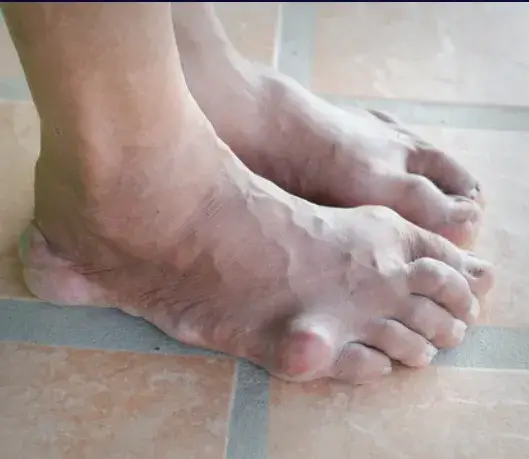Sprained Ankle Recovery: A Complete Guide from Injury to Pain-Free Steps
Depending on the degree of injury, the healing period for a sprained ankle varies. While grades 1-2, which are low and moderate, can be completed in three to six weeks, grades three can take several months.
An ankle sprain is a common musculoskeletal injury affecting people of all ages, athletes and non-athletes alike. Ankle ligaments can get stretched or torn, resulting in pain, edema, and difficulty walking. Many choose not to go for medical attention for ankle problems, instead choosing to care at home.
However, it’s important to consult a physician if an ankle sprain results in more than just minimal discomfort and swelling. A severely injured ankle may not heal effectively and may lose its stability and range of motion without the right care and rehabilitation, which might lead to prolonged rest and recurring sprains.
What is a Sprained Ankle?
A sprained ankle is a common illness that happens when you move or twist your ankle, or when the ankle ligaments are pulled or stretched too far this usually happens after a fall. While most sprains heal on their own, strengthening the affected muscles with treatment may help prevent future sprains.
What is the difference between a sprained ankle and an ankle fracture?
Ankle sprains are caused by tears in the ligaments that support the ankle. When one or more of the ankle’s bones break you have a broken ankle or ankle fracture. Severe sprains and fractures are both brought on by twisting or rotating your ankle, tripping and falling, or damage to your ankle. They both present with similar signs, such as pain, swelling, bruising, and tenderness. Ankle fractures can take up to six weeks to recover, although sprains heal more quickly.
Who does it affect?
Any age group can suffer from an ankle sprain. While they can occur during regular activity, sprains are most frequently experienced by athletes during competitions.
Types of Ankle Sprains
Ankle sprains can be classified into three categories according to the degree of ligament damage:
- Grade 1 (Mild). There is a little tear or a tiny stretch in the ligament fibers. There will be some slight swelling and pain to the touch of your ankle.
- Grade 2 (Moderate). It’s not a full tear; the ligament is torn. The area around the damage on your ankle is swollen, making movement painful.
- Grade 3 (Severe). The ligament is completely cut. Walking is difficult, the injury is painful, and your ankle has swelling excessively.
Symptoms of a Sprained Ankle
The symptoms of a sprained ankle include:
- Ankle pain, particularly when bearing weight on it.
- Tenderness to the touch.
- Swelling.
- Bruising.
- Difficulty walking.
Causes a Sprained Ankle
The following are typical causes of ankle sprains:
- Suddenly twisting the foot
- Falling or tripping on uneven surfaces.
- Landing wrongly after a jump.
- Losing balance.
- playing sports (tennis, basketball, football, soccer) where you have to roll or twist your foot.
Diagnosis and Tests
After performing a physical examination of your foot and ankle to measure your range of motion and identify the injured ligaments, your healthcare professional will make the diagnosis of a sprained ankle. After the physical examination, an imaging test, such as an X-ray, is usually performed.
How can I explain if my ankle is sprained?
You may think that you have a sprained ankle if you slipped or twisted it and the damage causes you to experience pain, swelling, or bruising plus difficulty walking. Your healthcare professional will examine the injuries, verify the diagnosis, and prescribe a course of therapy when you visit them.
Ankle sprain types and respective recovery periods
If you have been diagnosed you have an ankle sprain, you are probably wondering how severe the sprain is, and how long it will take to recover. An ankle sprain affects one or more of the ligaments that join the bones in your leg to the bones in your foot. Ligaments may be damaged or stretched when you sprain your ankle.
The following is how the estimated recovery times match these grades:
First-degree or grade 1 ankle sprain
a first-degree sprain is a minor ligament tear that results in minimal discomfort and swelling and usually heals fast. Most first-degree sprains heal in three weeks. However, some people heal faster than others, taking as little as four or five weeks.
Second-degree or grade 2 ankle sprain
A second-degree sprain is a little severe. it often involves 50% of the ligament being ruptured causes greater swelling and pain, and limits movement. If a second-degree sprain is confirmed, you should expect a longer healing period than four weeks. A second-degree sprain typically takes four to six weeks to heal.
Third-degree or grade 3 ankle sprain
A full tear, or third-degree sprain, will require more time to recover. It will need some patience to recover from this sprain because it could take three to six months.
How should an ankle sprain be treated?
The most useful way to treat an ankle sprain starts with a proper diagnosis and treatment plan.
Step 1: RICE
In the initial phase, you have to take rest to prevent further injury.
- Rest
- Decrease the swelling
- Prevent further injury
- R: rest the ankle
- I: ice for twenty minutes, three to four times a day
- C: apply compression (if needed)
- E: Elevate the foot.
- If surgery is not needed, you will move on to the recovery and rehab phase.
Step 2: Recovery
After an injury, the discomfort may quickly go down and your ankle’s range of motion and functionality may improve in the first two weeks. Depending on the responsibilities of their everyday lives, some people can resume their activities in one to three weeks. some people can still be in discomfort a year after suffering an ankle injury.
Early intervention is therefore essential. Unless your doctor instructs you otherwise, beginning weight-bearing activities as soon as possible and carefully can help with the healing process, assuming there isn’t a fracture involved.
If an ankle sprain is not adequately treated with physical therapy and medication, the ligament may repair somewhat stretched, which may result in more sprains of the ankle. The talus, the domed bone at the top of the ankle, can occasionally become extremely rigid, which can impair ankle movement.
Additionally, the fibula can move slightly anteriorly. A qualified physical therapist can use mobilization to help restore normal motion and function if this occurs. While initial shifts in gait may be protective. it advised returning to regular gait patterns as soon as feasible.
Step 3: Rehabilitation
Physical therapists should conduct a supervised and targeted exercise program to promote a quicker return to sports and activities as well as prevent re-injury. doing so will speed up healing, boost ankle strength and confidence, stop the injury from happening again, and enable a confident return to a regular lifestyle.
A good rehabilitation program includes:
- Restoring the range of motion
- Gaining ankle muscle strength
- Improving balance
Additionally, The training specifically in balance and control can:
- Accelerate the recovery of an ankle sprain
- Prevent the recurrence of an ankle sprain
- Prevent the long-term risk of chronic ankle instability
Medications are used for a sprained ankle:
Ibuprofen and other anti-inflammatory medications may help reduce sprain-related pain and swelling.
How do I take care of myself?
You must regain your ankle’s strength and flexibility after using the PRICE approach to treat your sprain. To increase your range of motion, do the exercises that your physical therapist or healthcare practitioner has prescribed.
Physical therapy exercises include:
- Motion-controlled movements without resistance.
- Strengthening exercises for the tendons and muscles in your front and back legs.
- Balance training (proprioception) to prevent future sprains.
- Exercises for calf and ankle strength that combine endurance and agility.
Early exercises in your treatment plan will not require you to turn or twist your ankle, but over time, You’ll be able to resume routine activities (like playing basketball or football) that may require quick turns.
When should I see my healthcare provider?
If you are unable to walk following an injury and your pain and swelling have not decreased or have become worse 24 to 48 hours after the sprain, you should consult your physician for a severe sprain treatment.
What questions should I ask my doctor?
- How severe is my sprain?
- Is this a ligament tear or is my ankle fracture?
- Do you recommend using crutches?
- Should I visit a physical therapist to improve the strength of my ankle?
How you can differentiate an ankle sprain and a high ankle sprain?
Depending on the area and ligaments affected, a high ankle sprain and an ankle sprain are different from one another. Two location-based classifications are used to categorize ankle sprains:
- Inversion. The most frequent type of sprain is an inversion sprain, which happens when the ligament on the outside of the ankle tears and the ankle twists in or out. Inversion sprains are caused by accidents and slips.
- External rotation. An injury caused by external rotation tears the syndesmosis ligament, which is located between the tibia and fibula. A common sports injury is also known as a high ankle sprain.
Prevention
To prevent ankle sprains, you can:
- Maintain good muscle strength by exercising regularly.
- Stretch and warm up before participating in physical activity or exercise.
- When you run or walk, be aware of any uneven ground.
- During activities or exercise, if you feel fatigued, slow down or stop.
Prognosis
You’ll be able to resume your normal activities after giving your ankle time to heal and treat the sprain by your doctor’s instructions. Your prognosis is dependent upon your dedication to strengthening your ankle through rehabilitation and activity. Should you cease the strengthening workouts or your ankle hasn’t healed entirely, you run the chance of your wounded ligament weakening and getting sprained again.
Note
The most difficult period following an ankle sprain is the first 24 to 48 hours, however at-home remedies like cooling and elevating the leg to lessen swelling can help alleviate symptoms.
After a sprain, strengthening your ankle might help avoid more sprains. You should always be aware of the surfaces you’re working out on or walking on to prevent accidents that could cause sprains.
FAQ
When will the swelling from my sprained ankle go away?
Normal swelling doesn’t show up immediately. It might not develop for several hours. If you get mild to moderate sprains, you could experience swelling that lasts for up to 48 hours. Severe sprains may cause swelling that lasts longer until the damaged ligament recovers.
Do I require physical therapy after an ankle sprain?
Physical therapy may be recommended by your healthcare practitioner to assist you in regaining stability and mobility. Athletes frequently receive physical therapy, which allows them to resume their sport when the injury heals. Physical therapy is beneficial for proper healing.
Is surgery required to treat my ankle sprain?
An acute ankle sprain is rarely treated with surgery. Your doctor may suggest surgery if you have severe ankle problems such as instability or rolling your ankle frequently.
Do sprains of the ankle heal themselves?
Although most sprains heal on their own, strengthening your ankle might help prevent further harm. You risk having recurrent ankle sprains or chronic ankle instability if you don’t give your ankle ligaments enough time to recover. You can have a chronic ankle sprain if your symptoms continue for more than four to six weeks following the accident and you still have weakness when walking on your foot.
What is the healing time for a sprained ankle?
The amount of time it takes to heal from a sprained ankle varies depending on how serious the damage is. A small sprain may heal in two weeks, whereas a major sprain may take six to twelve weeks to heal.
References
- Professional, C. C. M. (n.d.-i). Sprained ankle. Cleveland Clinic. https://my.clevelandclinic.org/health/diseases/22048-sprained-ankle
- Robert Sheffey, DPM. (n.d.). How long do I need to rest my sprained ankle?: Chicagoland Foot and Ankle: Board-certified foot and ankle specialists and surgeons. https://www.chicagolandfootandankle.com/blog/how-long-do-i-need-to-rest-my-sprained-ankle
- Lindberg, S. (2021b, March 11). How long does it take for a sprained ankle to heal? Healthline. https://www.healthline.com/health/how-long-does-it-take-for-a-sprained-ankle-to-heal
- Previti, R. (2024, January 10). How long does a sprained ankle take to heal And other questions. EmergeOrtho. https://emergeortho.com/news/how-long-do-sprained-ankles-last/






